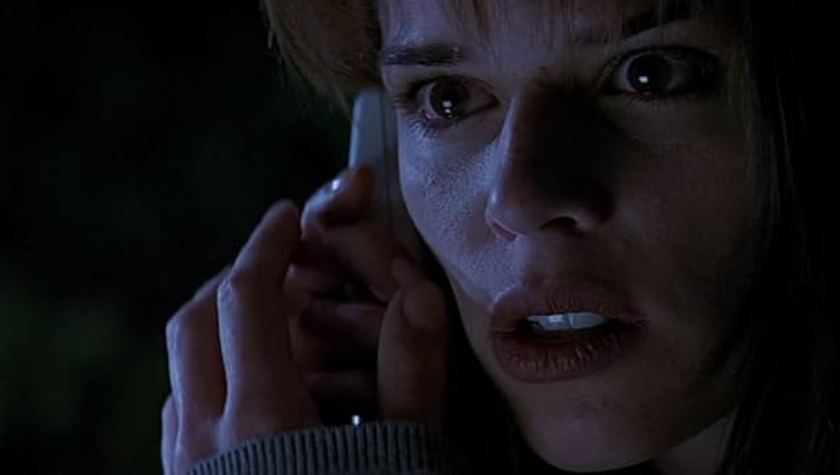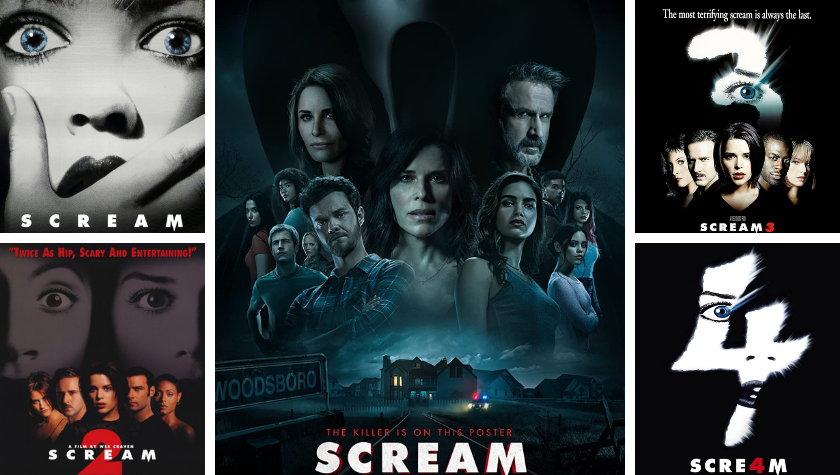5 Screenwriting Takeaways: How ‘Scream’ makes a self-aware sequel/reboot
January 21, 2022
What’s a requel? It’s sort of like a sequel, but also something like a reboot. It’s what Halloween did when it brought back Jamie Lee Curtis or what the Saved by the Bell show did when rebooting the series. This is what Scream, the latest film in the franchise, tackles as the Ghostface killer returns to play a game with a whole new cast of characters: How to survive a horror requel.
Just like the four films that preceded Scream (2022), each movie had certain rules that the characters had to follow in order to survive. This list of rules became a staple in the series when, in the first film, Randy (Jamie Kennedy) explained how he and his friends could make it out of their life-turned-movie alive, and led to his famous reciting of the rules.
The Scream franchise has always been very much self-aware of what it is, which makes viewing them particularly fun because it points out the obvious tropes in horror, criticizes the popular trends of the genre, and then proceeds to play on the expectations of the audience. The 2022 requel of Scream is no exception — it has its own set of rules.
Scream (2022) is the fifth film in the franchise and was directed by Matt Bettinelli-Olpin and Tyler Gillett, and written by James Vanderbilt and Guy Busick. The film reunites Neve Campbell, Courteney Cox, and David Arquette and brings on new victims — I mean cast members — Melissa Barrera, Jenna Ortega, and Jack Quaid.
Here are five screenwriting takeaways from Scream (2022).
1. Always start with a suspenseful moment
Everyone knows what happens at the beginning of a Scream movie. Our would-be killer calls a teenage girl, eases her into a phone call, and discusses scary movies. This then prompts a game that leads to the infamous Ghostface jumping out and chasing the damsel in distress around the home before killing her. This meets the expectations of the audience while also starting off the story with a mystery. Each preceding film began this way and the initial murder had something to do with the broader story.
Writers can note that a good way to start off a scary movie is with an intense moment that sets up the story and a mystery. The Saw films started out in a similar fashion with a gruesome death at the beginning related to the overall story.
2. Know the horror movie tropes
There is likely no other movie franchise out there that makes use of the horror movie tropes more so than Scream. Its entire existence centers on scary movies and how to successfully survive them to the point that each film preceding this one discusses ways its characters can discover who the killer is while also avoiding death.
The latest version is no exception. In the original Scream, there are rules set to survive a scary movie. In this version, the question posed is, “How do you survive a horror requel?” What gets laid out is a series of tropes used in horror movie requels that explain how they can make it out of this one alive.
Whether you’re writing the next Scream or working on an original horror movie, it’s critical to be aware of tropes so you can use them to your advantage. In fact, whatever genre you write, it’s important to know the tropes. Just like the opening scene in Scream (2022), there are expectations the audience has when walking into a scary movie.
3. Relation to the previous films
Sequels can be tricky. The first film sets up the universe and the characters within it, whereas sequels then must expand where that story left off, whether it’s been one year (such as the time between Scream and Scream 2) or over a decade (such as the time between Scream 4 and the latest Scream). It also means that for the audience to fully enjoy the sequel, they must have seen the previous films.
One question that kept popping up recently was, “Do I have to see all the other Spider-Man movies before seeing Spider-Man: No Way Home?” The answer was they probably did, or at least be very aware of them.
Scream (2022) is similar. For the viewer to understand the backstories and invest in the characters, they should have seen the original Scream.
Writers have a difficult balancing act in situations like this. They must explain what previously happened to educate any newcomers to the franchise without boring those who have heard the story of Sidney Prescott (Campbell) and the Woodsboro massacre.
4. Why do we care?
With a sequel, there is always a built-in audience who cares about the characters. Most of those who have seen the previous films are interested in how the stories of Sidney, Gale (Cox), and Dewey (Arquette) will play out. Will any of them get killed? How does their story tie in with the new crop of taunted victims?
And why should we care about these new characters? What writers can see is how to create compelling new characters that enhance the story of the film itself along with the previous characters from other films. If Ghostface found a new group of teenagers to terrorize, it might be entertaining, but it wouldn’t have the impact it does if there is a connection. The Halloween films were losing their luster until the franchise brought Jamie Lee Curtis back and connected Michael Myers to the original story.
5. Study movies
If you want to be a screenwriter you should be doing two things: reading scripts and watching movies. Both help give the writers knowledge. Scream uses the knowledge of movies as a way to show it is self-aware and add a unique spin on the movie-going experience. Scream, in its own strange way, is an unfunny spoof, created as a seeming love letter to the genre.
How does this help writers? Hopefully, you’re writing the movies you want to see, which means there are probably movies that you’ve seen and loved. Writers can make the “love letters” of the movies they want to see and take advantage of nostalgia to hook an audience. Quentin Tarantino films are another perfect example of this.
Scream (2022) is now playing in theaters.
Written by: Steven Hartman
Steven Hartman is an award-winning, optioned screenwriter. He was a Top 5 Finalist in Big Break’s Historical Category in 2019 and won Best Action/Adventure in Script Summit’s Screenplay Competition in 2021. He holds a Bachelor of Arts degree from Columbia College and had internships at Jerry Bruckheimer Films and Village Roadshow Pictures. Steve is a full-time writer and creative video producer by day and a screenwriter and novelist by night.



